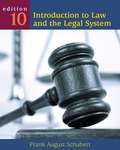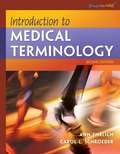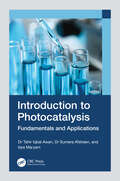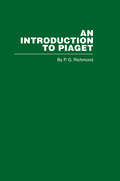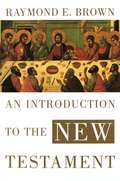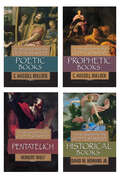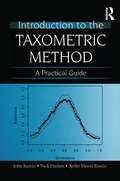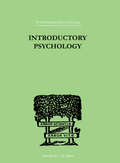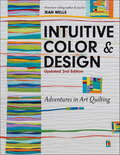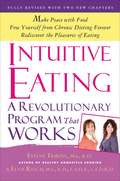- Table View
- List View
Introduction to Labour and Industrial Laws
by Dr Avtar Singh Prof Dr Harpreet KaurIntroduction to Labour and Industrial Laws by Avtar Singh offers a comprehensive overview of key principles governing employment and industrial relations in India. The book covers major labour legislations, including laws on wages, working conditions, social security, and trade unions. It explains the evolution and objectives of labour laws in a clear, accessible manner. Special focus is given to the rights and duties of employers and employees within the legal framework. Ideal for law students and professionals, it bridges theoretical understanding with practical application.
Introduction to Law Practice: Organizing and Managing Legal Work
by Gary A. MunnekeThis casebook introduces practice management skills in a variety of areas, including formation of a firm, development of a marketing plan, hiring and retaining staff, setting up a law office, leveraging the lawyer's intellectual work product, marshalling IT resources, establishing office systems, setting and collecting fees, and managing a budget. The new edition features an entirely new first section called "The Business of Law" which focuses on the economics of the profession and looks at the changing business model of law firms and billing practices. This edition also has new sections focusing on creating "practice-ready" lawyers
Introduction to Law and the Legal System 10th Edition
by Frank August SchubertThis text is a survey of the American legal system and can be used in a variety of courses such as Survey of Law, Introduction to Law and the Legal System, Law and Society, Legal Environment and Business, and Legal Process.
Introduction to Medical Terminology
by Ann Ehrlich Carol L. SchroederDesigned for the beginning health care student, Introduction to Medical Terminology, Second Edition, simplifies the process of learning hundreds of complex medical terms. The See and Say pronunciation system makes pronouncing unfamiliar terms easy. Because word parts are integral to learning medical terminology, mastery of these "building blocks" is emphasized in every chapter. Organized by body system, chapters begin with an overview of the structures and functions of that system so you can relate these to the specialties, pathology, diagnostic, and treatment procedures that follow. A workbook offers word part and comprehensive medical terminology reviews, flashcards, and learning exercises in a variety of formats that require written answers.
Introduction to Medical Terminology
by Ann Ehrlich Carol L. SchroederDesigned for the beginning health care student, INTRODUCTION TO MEDICAL TERMINOLOGY 3E simplifies the process of learning hundreds of complex medical terms. The See and Say pronunciation system makes pronouncing unfamiliar terms easy. Because word parts are integral to learning medical terminology, mastery of these "building blocks" is emphasized in every chapter. Organized by body system, chapters begin with an overview of the structures and functions of that system so you can relate these to the specialties, pathology, diagnostic, and treatment procedures that follow. A workbook offers word part and comprehensive medical terminology reviews, flashcards, and learning exercises in a variety of formats that require written answers.
Introduction to Photocatalysis: Fundamentals and Applications
by Tahir Iqbal Awan Sumera Afsheen Iqra MaryamExplore the intriguing world of photocatalysis with Introduction to Photocatalysis: Fundamentals and Applications. This book explores the complexities of photocatalytic processes, investigating the contributing elements, nano-photocatalyst manufacturing methodologies, and their wide applications in the energy and environmental sectors.Additionally, sophisticated modification approaches that may be used to improve the efficiency of visible light-driven processes (such as doping and plasmonics photocatalysis) are discussed. Key features include novel methodologies of photocatalysts, providing an insight on fundamentals and methodology; and examples of efficient applications of photocatalysis such as wastewater treatment, hydrogen production and CO2 reduction. Later chapters discuss the commercial aspects of photocatalysis to help guide future entrepreneurs.The book is useful for advanced undergraduates, and graduate students in a range of subjects such as physics, biotechnology, and biochemistry. This book will also prove invaluable for researchers and scientists in photocatalysis, and chemical engineers and chemists in industry R&D working on wastewater treatment and renewable sources of energy. It stands out as a modernized version of current literature that bridges the gap between scholars and students.
Introduction to Piaget
by R.G. RichmondFirst published in 2006. Routledge is an imprint of Taylor & Francis, an informa company.
Introduction to Probability, Second Edition (Chapman & Hall/CRC Texts in Statistical Science #112)
by Joseph K. Blitzstein Jessica HwangDeveloped from celebrated Harvard statistics lectures, Introduction to Probability provides essential language and tools for understanding statistics, randomness, and uncertainty. The book explores a wide variety of applications and examples, ranging from coincidences and paradoxes to Google PageRank and Markov chain Monte Carlo (MCMC). Additional application areas explored include genetics, medicine, computer science, and information theory. The authors present the material in an accessible style and motivate concepts using real-world examples. Throughout, they use stories to uncover connections between the fundamental distributions in statistics and conditioning to reduce complicated problems to manageable pieces.The book includes many intuitive explanations, diagrams, and practice problems. Each chapter ends with a section showing how to perform relevant simulations and calculations in R, a free statistical software environment. The second edition adds many new examples, exercises, and explanations, to deepen understanding of the ideas, clarify subtle concepts, and respond to feedback from many students and readers. New supplementary online resources have been developed, including animations and interactive visualizations, and the book has been updated to dovetail with these resources. Supplementary material is available on Joseph Blitzstein’s website www. stat110.net. The supplements include:Solutions to selected exercisesAdditional practice problemsHandouts including review material and sample exams Animations and interactive visualizations created in connection with the edX online version of Stat 110.Links to lecture videos available on ITunes U and YouTube There is also a complete instructor's solutions manual available to instructors who require the book for a course.
Introduction to Research Methods 5th Edition: A Practical Guide for Anyone Undertaking a Research Project
by Catherine DawsonIntroduction to Research Methods contains everything from developing an initial idea into a proposal, through to analysing data and reporting results. Whether you have to undertake a project as part of your coursework, or as part of your employment, or simply because you are fascinated by something you have observed and want to find out more, this book offers you advice on how to turn your ideas into a workable project. Specifically it will show you how to: *Choose your research methods*Choose your participants*Prepare a research proposal*Construct questionnaires*Conduct interviews and focus groups*Analyse your data*Report your findings *Be an ethical researcher
Introduction to Research Methods 5th Edition: A Practical Guide for Anyone Undertaking a Research Project
by Dr Catherine DawsonIntroduction to Research Methods contains everything from developing an initial idea into a proposal, through to analysing data and reporting results. Whether you have to undertake a project as part of your coursework, or as part of your employment, or simply because you are fascinated by something you have observed and want to find out more, this book offers you advice on how to turn your ideas into a workable project. Specifically it will show you how to: *Choose your research methods*Choose your participants*Prepare a research proposal*Construct questionnaires*Conduct interviews and focus groups*Analyse your data*Report your findings *Be an ethical researcher
Introduction to SNOMED CT
by S. B. BhattacharyyaAs a general introduction to the SNOMED CT clinical terminology code system, the book explains in simple terms a wealth of key aspects, including the fundamentals of SNOMED CT, the various ways in which it can be used, and the methods by which it may quickly be deployed for use within an electronic documentation system that deals with clinical and clinics-related data. Further considerations include how end users can employ the system, how healthcare IT designers and developers can build highly ergonomic systems, and how health informatics experts and clinical analysts can successfully harness the various features that the clinical terminology code system provides in order to unleash the hidden potentials of clinical data. The book brings together material from various sources, presenting it in an easy-to-follow manner and supplemented by analyses of a number of different (imaginary) scenarios including case summaries from the author's experience and knowledge. The book will greatly benefit all stakeholders involved: clinicians, nurses, paramedics, dentists, public health professionals, health informatics professionals and healthcare IT engineers involved in the design and development of information systems for healthcare. Students at both the undergraduate and postgraduate levels seeking a practical introduction to SNOMED CT will find this book to be a valuable guide.
Introduction to Structural Equation Modeling Using IBM SPSS Statistics and Amos
by Niels BlunchThis comprehensive Second Edition offers readers a complete guide to carrying out research projects involving structural equation modeling (SEM). Updated to include extensive analysis of AMOS' graphical interface, a new chapter on latent curve models and detailed explanations of the structural equation modeling process, this second edition is the ideal guide for those new to the field. The book includes: - Learning objectives, key concepts and questions for further discussion in each chapter. - Helpful diagrams and screenshots to expand on concepts covered in the texts. - Real life examples from a variety of disciplines to show how SEM is applied in real research contexts. - Exercises for each chapter on an accompanying companion website. - A new glossary. Assuming no previous experience of the subject, and a minimum of mathematical knowledge, this is the ideal guide for those new to SEM and an invaluable companion for students taking introductory SEM courses in any discipline. Niels J. Blunch was formerly in the Department of Marketing and Statistics at the University of Aarhus, Denmark
Introduction to the Economic History of China
by Stuart KirbyFirst Published in 2005. Routledge is an imprint of Taylor & Francis, an informa company.
Introduction to the New Testament
by Raymond E. BrownEvery generation needs a comprehensive, reliable Introduction to the New Testament that opens the biblical text to the novice. Raymond E. Brown's An Introduction to the New Testament is the most trustworthy and authoritative guidebook for a generation seeking to understand the Christian Bible. Universally acknowledged as the dean of New Testament scholarship, Father Brown is a master of his discipline at the pinnacle of his career. Who else could cover the entire scope of the New Testament with such ease and clarity? This gifted communicator conveys the heartfelt concern of a beloved teacher for his students, as he walks the reader through the basic content and issues of the New Testament. While the book contains a wealth of information, its most impressive features are how the author boils down a life time of scholarship into basic summaries of each book, provides a historical overview of the ancient Greco-Roman world, engages in discussions of theological issues, and presents supplementary material for deeper understanding, such as tables, maps, bibliographies, and appendixes. Those opening to the New Testament for the first time and those seeking deeper insights could not ask for more in a primer to the Christian Bible.
Introduction to the Nonprofit Sector: A Practical Approach for the Twenty-first Century
by Gary M. GrobmanThis is an introductory text on the nonprofit sector and nonprofit organizations. It provides an overview of the history, theory, and scope of the nonprofit sector. It discusses issues facing nonprofits, such as legal and regulatory issues, ethics, quality, fiscal, and liability issues. It also provides practical guidelines for writing mission and vision statements, strategic planning, hiring, firing, lobbying, communicating, using the Internet, and other functions of nonprofit organizations. Each chapter includes a synopsis at the beginning, as well as discussion questions, activities, and bibliographic references at the end. An index is included.
Introduction to the Old Testament, set of four books (Prophetic, Poetic, Pentateuch, Historical)
by C. Hassell Bullock Herbert Wolf David M. Howard Jr.This package contains all four books of An Introduction to the Old Testament set: An Introduction to the Old Testament Historical Books, An Introduction to the Old Testament Poetic Books, An Introduction to the Old Testament Prophetic Books,and An Introduction to the Old Testament Pentateuch.In An Introduction to the Old Testament Historical Books, incredible events, amazing love stories, larger-than-life personalities and deep theological implications and themes are just part of the treasure that awaits readers. These books tell the story of the nation of Israel and the God who loves her, punishes her, and always brings this recalcitrant people back to Himself. In An Introduction to the Old Testament Poetic Books, C. Hassell Bullock, a noted Old Testament scholar, delves deep into the hearts of the five poetic books, offering readers helpful details such as hermeneutical considerations for each book, theological content and themes, detailed analysis of each book, and cultural perspectives. In An Introduction to the Old Testament Prophetic Books, C. Hassell Bullock presents a clear picture of some of history's most profound spokesmen--the Old Testament prophets--and the God who shaped them. Our generational distance from the age of the prophets might seem to be a measureless chasm. Yet we dare not make the mistake of assuming that passing years have rendered irrelevant not only the Old Testament prophets, but also the God who comprehends, spans, and transcends all time. In An Introduction to the Old Testament Pentateuch, Old Testament expert Herbert Wolf provides layreaders and scholars alike with a strong undergirding of understanding and knowledge in this introduction that reveals both the seriousness and excitement of the Pentateuch.
Introduction to the Old Testament, set of four books (Prophetic, Poetic, Pentateuch, Historical)
by C. Hassell Bullock Herbert Wolf David M. Howard Jr.This package contains all four books of An Introduction to the Old Testament set: An Introduction to the Old Testament Historical Books, An Introduction to the Old Testament Poetic Books, An Introduction to the Old Testament Prophetic Books,and An Introduction to the Old Testament Pentateuch.In An Introduction to the Old Testament Historical Books, incredible events, amazing love stories, larger-than-life personalities and deep theological implications and themes are just part of the treasure that awaits readers. These books tell the story of the nation of Israel and the God who loves her, punishes her, and always brings this recalcitrant people back to Himself. In An Introduction to the Old Testament Poetic Books, C. Hassell Bullock, a noted Old Testament scholar, delves deep into the hearts of the five poetic books, offering readers helpful details such as hermeneutical considerations for each book, theological content and themes, detailed analysis of each book, and cultural perspectives. In An Introduction to the Old Testament Prophetic Books, C. Hassell Bullock presents a clear picture of some of history's most profound spokesmen--the Old Testament prophets--and the God who shaped them. Our generational distance from the age of the prophets might seem to be a measureless chasm. Yet we dare not make the mistake of assuming that passing years have rendered irrelevant not only the Old Testament prophets, but also the God who comprehends, spans, and transcends all time. In An Introduction to the Old Testament Pentateuch, Old Testament expert Herbert Wolf provides layreaders and scholars alike with a strong undergirding of understanding and knowledge in this introduction that reveals both the seriousness and excitement of the Pentateuch.
Introduction to the Practice of Statistics, Seventh Edition
by David S. Moore George P. McCabe Bruce A. CraigWith its focus on data analysis, statistical reasoning, and the way statisticians actually work, Introduction to the Practice of Statistics (IPS) helped bring the power of critical thinking and practical applications to today's statistics classroom. Unlike more traditional "plug and chug" /formula driven texts, IPS de-emphasizes probability and gives students a deeper understanding of statistics.
Introduction to the Semantics of Law (Law and Visual Jurisprudence #6)
by Andrzej MalecThis book offers an introduction to the language of law from the perspective of logical semantics. As a logical tool, Boguslaw Wolniewicz’s formal ontology of situations is adapted. The central issue addressed is the meaning of normative statements, primarily legal norms. The main outcome of the book consists in explications of several legal notions (including legal events, legal acts and legal rules) in terms of the formal ontology of situations. In addition, the book concludes that legal norms are sentences in a logical sense, so some are true, while others are false, and that their logical value does not depend on whether or not they were adopted in the law-making process. Lastly, the book contends that there are semantic relations between orders that are similar to entailment, contradiction, opposition, and sub-opposition, despite the fact that orders are not sentences in a logical sense, i.e., they are neither true nor false.The book also presents some original Wittgenstein-style deontic logics built on the first order logic. The formal results are applied to selected problems in the theory of law, including the problem of the possibility of algorithmic application of legal norms.
Introduction to the Taxometric Method: A Practical Guide
by Nick Haslam John Ruscio Ayelet Meron RuscioIntroduction to the Taxometric Method is a user-friendly, practical guide to taxometric research. Drawing from both classic and contemporary research, it provides a comprehensive introduction to the method. With helpful tools and guidance, the book is intended to teach those new to the method, as well as those already familiar with it, tips on how to conduct and evaluate taxometric investigations. The book covers a broad range of analytic techniques, describing their logic and implementation as well as what is known about their performance from systematic study. The book opens with the background material essential to understanding the research problems that the taxometric method addresses. The authors then explain the data requirements of taxometric analysis, the logic of each procedure, factors that can influence results and lead to misinterpretations, suggestions for choosing the best procedures, and methodological safeguards to prevent erroneous conclusions. Illustrative examples of each procedure and consistency test demonstrate how to perform analyses and interpret results using a variety of data sets. A checklist of conceptual and methodological issues that should be addressed in any investigation is included. The downloadable resources provide a variety of programs for performing taxometric analyses along with simulations and analyses of data sets. Introduction to the Taxometric Method is ideal for researchers and students conducting or evaluating taxometric studies in the social and behavioral sciences, especially those in clinical and personality psychology, as well as those in the physical sciences, education, biology, and beyond. The book also serves as a text for courses on this method, or as a supplement in psychological assessment, statistics, or research methods courses. Familiarity with taxometrics is not assumed.
Introductory Horticulture, 4th Edition
by H. Edward Reiley Carroll L. ShryThis step-by-step text covers the basic principles of horticulture and their practical applications. Topics include: interior plantscape and xeriscaping, biological pest control, seasonal greenhouse crops, fruit and vegetable gardens, Easter lilies, perennials, micro-propagation or tissue culture, bow-making, corsages and boutonnieres, and pesticides.
Introductory Psychology: AN APPROACH FOR SOCIAL WORKERS (International Library Of Psychology Ser.)
by Price-Williams, D RFirst published in 1999. Routledge is an imprint of Taylor & Francis, an informa company.
Intuitive Color & Design: Adventures in Art Quilting
by Jean WellsThink outside the block and look what happens! Jean Wells gives you the assignment of your life: put away your ruler and use your inner vision to design and piece spectacular, free-form quilts you'd never have guessed you could create. In this updated edition of best-selling Intuitive Color & Design, Jean’s workshop assignments get your creative juices flowing, giving you challenges to expand your quilting horizons. Start by learning to see line and color; study the nuts and bolts of design; develop your color work and composition; and when you get stuck, there’s expert advice on problem solving. You will never see quiltmaking in the same way again. • Creative exercises take your use of color, line, design, and piecing in dramatic new directions • Use photographs and journals to find inspiration and develop your ideas with Jean’s updated, expert guidance • Learn innovative finishing techniques to show your quilts at their best • Classroom-proven techniques make the adventure easy for any quilter
Intuitive Eating: A Revolutionary Program That Works
by Evelyn Tribole Elyse ReschFirst published in 1995, Intuitive Eating has become the go-to book on rebuilding a healthy body image and making peace with food. We've all been there, angry with ourselves for overeating, for our lack of willpower, for failing at yet another diet. But the problem is not us; it's that dieting, with its emphasis on rules and regulations, has stopped us from listening to our bodies. Written by two prominent nutritionists, Intuitive Eating will teach you: * How to reject diet mentality forever *How our three Eating Personalities define our eating difficulties * How to find satisfaction in your eating * How to feel your feelings without using food * How to honor hunger and feel fullness * How to follow the ten principles of "Intuitive Eating", * How to achieve a new and safe relationship with food and, ultimately, your body * How to raise an "intuitive eater"--NEW! * The incredible science behind intuitive eating--NEW! This revised edition includes updates and expansions throughout, as well as two brand new chapters that will help readers integrate intuitive eating even more fully into their daily lives.
Invasive Plants: Guide to Identification and the Impacts and Control of Common North American Species
by Wallace Kaufman Sylvan Ramsey KaufmanNewly updated: &“Invasive plants are ecological tumors that degrade food webs wherever they go. The third edition of [this book] is an invaluable reference.&” —Douglas Tallamy, New York Times–bestselling author of Nature&’s Best Hope This easy-to-use, wide-ranging guide to invasive plants in North America features full-color photos and descriptions of more than 250 alien species—both terrestrial and aquatic—that are in some cases changing the landscape to an almost unimaginable degree. Accompanying text describes the plant&’s environmental and economic impacts as well as management techniques used to control it. Also included is an explanation of what an invasive is and a step-by-step identification key. Used by U.S. Forest Service botanists, this is an essential guide to understanding this unprecedented environmental challenge that is threatening biodiversity—and the human population that depends on it to survive. &“A colorful, general field guide to the major invasive plants of North America…packed with relevant information.&” —Great Plains Research: A Journal of Natural and Social Sciences &“A wonderful guide.&” —The Roanoke Star


